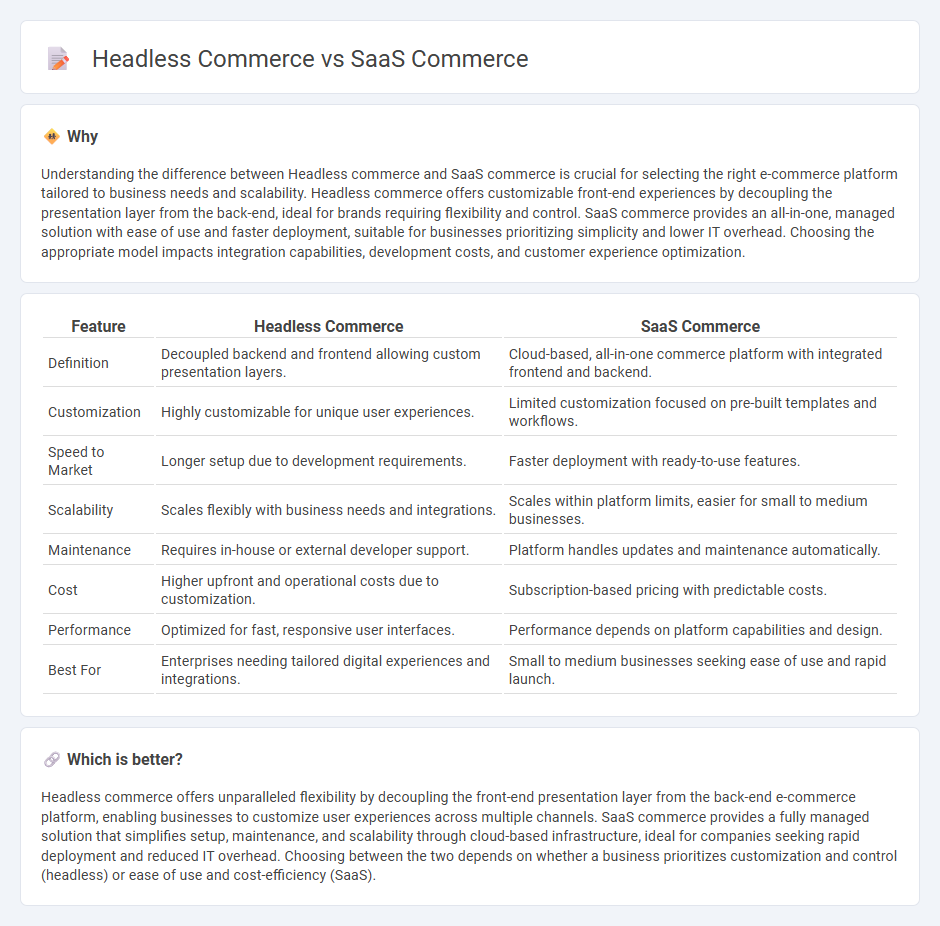
Headless commerce separates the front-end presentation layer from the back-end eCommerce functionality, enabling greater customization and flexibility for unique user experiences. SaaS commerce provides a fully managed, cloud-based platform with built-in features ideal for businesses seeking quick deployment and scalability without managing infrastructure. Explore the advantages and limitations of both solutions to determine the best fit for your commercial strategy.
Why it is important
Understanding the difference between Headless commerce and SaaS commerce is crucial for selecting the right e-commerce platform tailored to business needs and scalability. Headless commerce offers customizable front-end experiences by decoupling the presentation layer from the back-end, ideal for brands requiring flexibility and control. SaaS commerce provides an all-in-one, managed solution with ease of use and faster deployment, suitable for businesses prioritizing simplicity and lower IT overhead. Choosing the appropriate model impacts integration capabilities, development costs, and customer experience optimization.
Comparison Table
| Feature | Headless Commerce | SaaS Commerce |
|---|---|---|
| Definition | Decoupled backend and frontend allowing custom presentation layers. | Cloud-based, all-in-one commerce platform with integrated frontend and backend. |
| Customization | Highly customizable for unique user experiences. | Limited customization focused on pre-built templates and workflows. |
| Speed to Market | Longer setup due to development requirements. | Faster deployment with ready-to-use features. |
| Scalability | Scales flexibly with business needs and integrations. | Scales within platform limits, easier for small to medium businesses. |
| Maintenance | Requires in-house or external developer support. | Platform handles updates and maintenance automatically. |
| Cost | Higher upfront and operational costs due to customization. | Subscription-based pricing with predictable costs. |
| Performance | Optimized for fast, responsive user interfaces. | Performance depends on platform capabilities and design. |
| Best For | Enterprises needing tailored digital experiences and integrations. | Small to medium businesses seeking ease of use and rapid launch. |
Which is better?
Headless commerce offers unparalleled flexibility by decoupling the front-end presentation layer from the back-end e-commerce platform, enabling businesses to customize user experiences across multiple channels. SaaS commerce provides a fully managed solution that simplifies setup, maintenance, and scalability through cloud-based infrastructure, ideal for companies seeking rapid deployment and reduced IT overhead. Choosing between the two depends on whether a business prioritizes customization and control (headless) or ease of use and cost-efficiency (SaaS).
Connection
Headless commerce and SaaS commerce are connected through their focus on flexibility and scalability in e-commerce solutions. Headless commerce separates the frontend and backend, allowing businesses to customize user experiences independently, while SaaS commerce provides hosted, subscription-based platforms that simplify management and maintenance. Together, they enable retailers to rapidly deploy tailored, cloud-based e-commerce ecosystems optimized for performance and innovation.
Key Terms
API Integration
SaaS commerce platforms offer fully managed solutions with built-in API integrations that simplify deployment, ensuring rapid time-to-market and seamless connection with third-party services like payment gateways and CRM systems. Headless commerce separates the front-end and back-end, providing greater flexibility through customizable APIs, enabling businesses to tailor user experiences across multiple channels while maintaining robust data flow and control. Explore detailed comparisons to determine which API integration approach best aligns with your e-commerce strategy.
Customization
SaaS commerce platforms offer predefined templates and limited customization options, making them ideal for businesses seeking quick deployment and ease of use. Headless commerce provides extensive customization by decoupling the frontend from the backend, allowing brands to create unique, tailored digital experiences through APIs. Explore our in-depth comparison to understand which commerce model best suits your customization needs.
Infrastructure Separation
SaaS commerce solutions offer an all-in-one, managed infrastructure, simplifying deployment and maintenance but limiting customization and scalability compared to headless commerce. Headless commerce architecture separates the frontend and backend, enabling businesses to customize user experiences and integrate diverse technologies while independently scaling each component. Explore the distinct infrastructure benefits of SaaS and headless commerce to determine the ideal approach for your business needs.
Source and External Links
12 SaaS eCommerce Solutions to Boost Sales for Business | Clarity - SaaS commerce platforms are cloud-based software solutions that help eCommerce businesses manage inventory, orders, customer service, and automate processes to reduce costs, improve efficiency, and scale easily by adding features or integrating with third-party apps.
What is SAAS eCommerce? Pros, Cons, Future, Practices - SmartOSC - SaaS eCommerce offers benefits like faster time to market, easy integration and scalability, cost-effectiveness with subscription pricing, automatic updates, and user-friendly operation enabling businesses to quickly launch and grow their online stores.
Building Ecommerce SaaS: Types, Key Features, Benefits | SapientPro - SaaS ecommerce platforms provide regular updates, full technical support, scalability, package payment plans, platform integrity with a single development team, and automation via open APIs, allowing smooth business growth without technical hassles.
 dowidth.com
dowidth.com